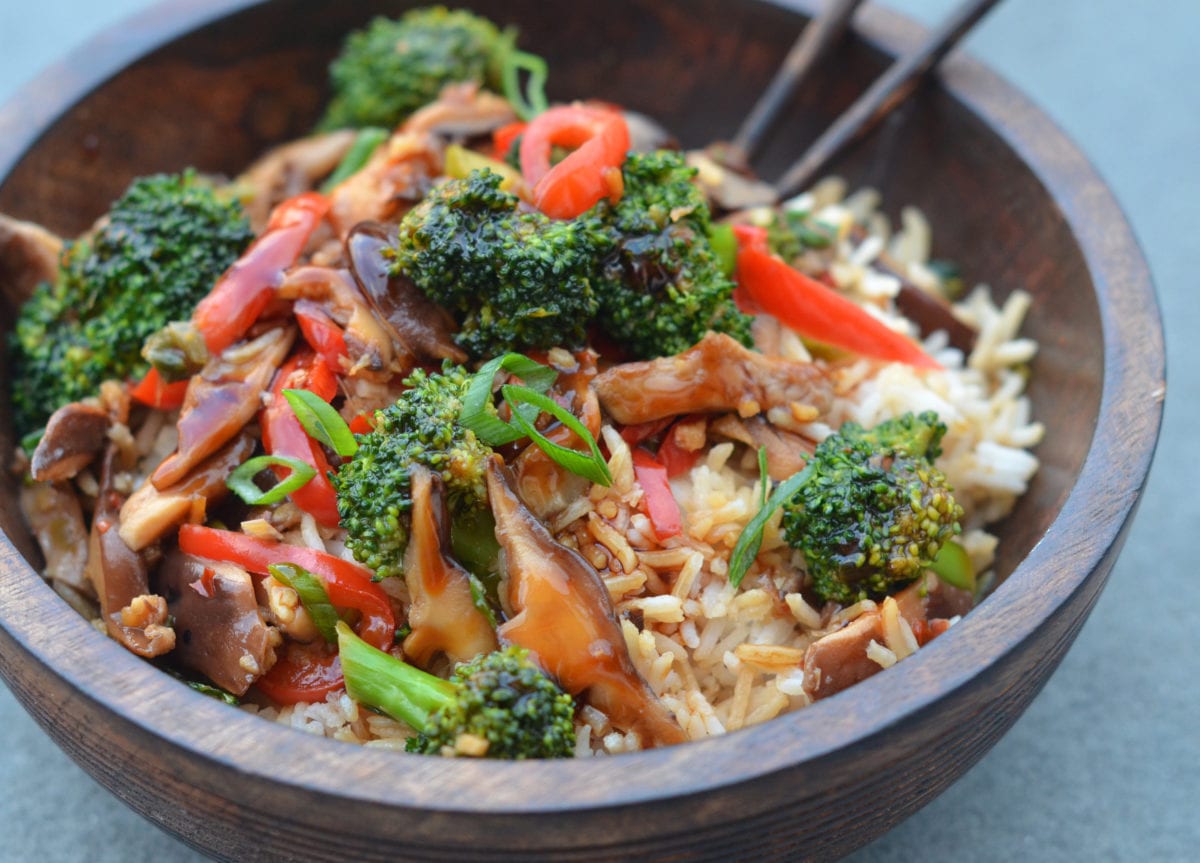Craving the vibrant flavors of Asian stir-fry but watching your carb intake? This guide unveils the secrets to creating a delicious, low-carb version right in your own kitchen. Imagine the tantalizing aroma of sizzling vegetables and savory protein, all while enjoying a guilt-free meal packed with flavor and nutrients. We’ll explore ingredient selection, sauce crafting, and cooking techniques to ensure a perfect, healthy stir-fry every time.
From selecting the crispiest low-carb vegetables to mastering the art of balancing sweet and savory flavors in your sauces, we’ll cover everything you need to know. Learn how to choose the best protein sources, create flavorful low-carb sauces using surprising alternatives to traditional ingredients, and perfect the stir-fry technique for maximum flavor and texture. Prepare to embark on a culinary adventure that satisfies both your taste buds and your health goals.
Ingredient Selection for Low-Carb Asian Stir-Fry
Crafting a delicious and healthy low-carb Asian stir-fry hinges on careful ingredient selection. The key is to choose vibrant, flavorful vegetables and lean protein sources while minimizing carbohydrates. This ensures a satisfying meal that aligns with your dietary goals.
Low-Carb Vegetables for Asian Stir-Fry
The beauty of a stir-fry lies in its versatility. A wide array of low-carb vegetables offer diverse textures and flavors, creating a visually appealing and exciting dish.
- Crisp & Crunchy: Broccoli florets, snap peas, shredded carrots, and sliced bell peppers (choose green or red for lower carb counts) provide a satisfying crunch. Serve these vegetables as a base for your stir-fry, allowing their textures to shine through.
- Tender & Delicate: Mushrooms (shiitake, oyster, or cremini), zucchini, and bok choy offer a softer texture that complements the crunchier elements. These are best added towards the end of the cooking process to retain their tenderness. Consider using a combination of these for a nuanced mouthfeel.
- Earthy & Savory: Asparagus spears and green beans contribute a subtle earthiness and satisfying bite. Their distinct flavors pair well with bolder protein sources and sauces. Roast these lightly before adding them to the stir-fry for an enhanced flavor profile.
Low-Carb Protein Sources for Asian Stir-Fry
Protein is crucial for satiety and overall nutritional balance. Several excellent low-carb options lend themselves beautifully to Asian stir-fries.
- Chicken Breast: A classic choice, chicken breast is lean, readily available, and cooks quickly. Its mild flavor allows it to absorb the rich flavors of the stir-fry sauce. Cubed or sliced chicken breast is ideal for stir-frying. Marinate it beforehand for enhanced taste and tenderness.
- Shrimp: Shrimp cooks rapidly and offers a delicate sweetness that complements many Asian flavors. Its high protein content and low carbohydrate count make it a perfect fit for this dish. Choose peeled and deveined shrimp for convenience.
- Tofu (firm or extra-firm): While not strictly a low-carb option, firm or extra-firm tofu offers a substantial protein source with relatively lower carbohydrates compared to other tofu varieties. Press the tofu to remove excess water before cutting it into cubes and stir-frying for a firmer texture. It absorbs the flavors of the sauce beautifully.
- Steak (Sirloin or Flank): Thinly sliced sirloin or flank steak stir-fries quickly and adds a rich, savory element to the dish. Its robust flavor can stand up to bold sauces. Ensure to slice it against the grain for optimal tenderness.
Low-Carb Sauce Comparison
The sauce is the heart of any stir-fry, adding flavor and depth. Several low-carb options provide the umami punch without the carbohydrate overload.
| Name | Carbohydrate Content (per tbsp) | Flavor Profile | Usage Suggestions |
|---|---|---|---|
| Coconut Aminos | ~1g | Slightly sweet, savory, with a subtle coconut undertone | Versatile base for many Asian-inspired stir-fries. |
| Soy Sauce (low sodium) | ~2g | Salty, savory, umami | Use sparingly due to higher carbohydrate content compared to coconut aminos. Best combined with other low-carb sauces to balance the flavor. |
| Tamari (gluten-free soy sauce) | ~2g | Rich, savory, slightly sweeter than regular soy sauce | Similar usage to low-sodium soy sauce; use moderately. |
| Fish Sauce | ~0g | Salty, pungent, umami, with a distinct fishy aroma | Adds a complex depth of flavor; use sparingly. Best combined with other sauces to balance the strong flavor. |
Step-by-Step Stir-Fry Cooking Process
Mastering the art of stir-frying hinges on precise timing and high heat. This technique allows you to coax vibrant colors and crisp-tender textures from your low-carb vegetables, creating a truly delightful Asian stir-fry. The following steps will guide you through the process, ensuring your vegetables retain their nutritional value and delicious flavor.
Preparing the Wok and Ingredients
Before you begin, ensure your wok or large skillet is screaming hot. A properly heated pan is crucial for achieving that signature stir-fry sear. Imagine the surface shimmering with a barely visible layer of oil, ready to instantly brown and crisp your ingredients. Meanwhile, meticulously prep your vegetables. Cut firmer vegetables like broccoli and carrots into similarly sized pieces to ensure even cooking. Delicate greens like spinach should be added towards the end of the cooking process. Having everything prepped and ready to go will prevent overcooking and maintain the integrity of each ingredient’s texture.
Stir-Frying the Vegetables
- Adding the Aromatics: Begin by adding a small amount of oil (about 1 tablespoon) to the blazing hot wok. Swirl the oil to coat the entire surface. Then, add aromatics like minced garlic and ginger. The fragrant oils will immediately sizzle and perfume the air as they release their potent flavors. Stir-fry for about 15 seconds, until fragrant, being careful not to burn them.
- Stir-frying Firmer Vegetables: Next, add your firmer vegetables such as broccoli florets, sliced bell peppers, and carrot pieces. Stir-fry continuously for 2-3 minutes, allowing them to develop a slight char on the edges while retaining a vibrant, crisp bite. Visualize the broccoli turning a bright, almost emerald green, the peppers exhibiting a glistening sheen, and the carrots developing a slightly softened texture, still retaining their shape.
- Adding Softer Vegetables: Once the firmer vegetables are partially cooked, add your softer vegetables, such as sliced mushrooms or snow peas. Continue to stir-fry for another minute or two, until they are tender-crisp. The mushrooms should have a delicate softness, releasing their earthy aromas, while the snow peas retain a vibrant green hue and a slight crunch.
- Finishing Touches: Finally, add any leafy greens like spinach or bok choy. These will wilt quickly in the residual heat. Stir-fry for only 30 seconds to a minute, until just wilted. Imagine the vibrant green spinach collapsing slightly, revealing a tender, yet still bright green color, and the bok choy wilting gracefully while retaining a delicate texture.
Seasoning and Serving
Once your vegetables are perfectly cooked, remove them from the wok and set aside. Add your low-carb sauce (previously prepared), stirring until it lightly thickens. Return the vegetables to the wok and toss gently to coat them evenly in the sauce. The sauce should cling beautifully to the vegetables, adding a glossy sheen and enhancing their natural flavors. Serve immediately, allowing the vibrant colors and crisp textures to take center stage.
Recipe Variations and Customization
The beauty of a stir-fry lies in its adaptability. This basic low-carb recipe serves as a springboard for countless culinary adventures, allowing you to tailor the dish to your specific tastes and dietary needs. Experimenting with different proteins, vegetables, and flavor profiles will keep your stir-fries exciting and prevent them from becoming monotonous.
Protein and Vegetable Variations
Three distinct variations demonstrate the recipe’s versatility. First, imagine a vibrant shrimp stir-fry featuring succulent, juicy shrimp, crisp-tender broccoli florets, and vibrant slivers of red bell pepper, all tossed in a fragrant garlic-ginger sauce. The sweetness of the peppers balances the savory shrimp and the subtle bitterness of the broccoli. For a richer flavor profile, consider adding a splash of toasted sesame oil.
Secondly, envision a hearty chicken and shiitake mushroom stir-fry. Tender pieces of chicken breast, earthy shiitake mushrooms, and the slight bitterness of bok choy create a satisfying and flavorful combination. A touch of soy sauce (or tamari for gluten-free) adds umami depth, while a sprinkle of toasted sesame seeds provides a delightful textural contrast. The mushrooms contribute a meaty texture that complements the chicken perfectly.
Finally, consider a succulent beef and cauliflower stir-fry. Thinly sliced beef, tender cauliflower florets, and vibrant green beans create a colorful and flavorful dish. The beef adds a hearty protein source, while the cauliflower provides a satisfying, low-carb alternative to rice or noodles. A simple sauce made with oyster sauce (or a vegan alternative) adds a savory richness that ties the flavors together. The cauliflower’s texture holds up well to the stir-frying process.
Dietary Adaptations
Adapting this recipe to various dietary restrictions is straightforward. For a vegetarian option, simply replace the protein source with firm tofu, pressed to remove excess moisture, or a hearty mix of mushrooms such as shiitake, cremini, and oyster mushrooms. Their earthy flavors and satisfying textures will fill the role of the protein admirably. To make the dish vegan, ensure all sauces and condiments are plant-based; many readily available options exist. A vegan oyster sauce, for instance, provides a similar savory depth.
Gluten-free adaptations are equally simple. Use tamari or coconut aminos instead of soy sauce, and ensure all other ingredients are naturally gluten-free. Carefully check labels to avoid hidden gluten in sauces or spice blends. Many gluten-free alternatives to traditional ingredients are now widely available.
Flavor Enhancement with Spices and Aromatics
Spices and aromatics are key to creating a flavorful and aromatic stir-fry. Ginger, with its warm, slightly spicy, and pungent notes, forms the base of many Asian stir-fries. Garlic, offering a sharp, pungent, and savory taste, complements ginger perfectly. Fresh chilies, depending on the type, offer a range of heat levels from mild to intensely fiery, adding a vibrant kick.
Consider using lemongrass for its citrusy, grassy fragrance that adds a refreshing dimension. Star anise, with its warm, licorice-like flavor, offers a unique complexity. For a subtle sweetness, add a touch of brown sugar or maple syrup (for vegan options). Experiment with different spice combinations to create unique flavor profiles; the possibilities are truly endless. Remember that a little goes a long way, so start with small amounts and adjust to taste.
Serving Suggestions and Presentation

Elevating your low-carb Asian stir-fry from a simple meal to a culinary masterpiece involves thoughtful consideration of serving suggestions and presentation. The visual appeal of your dish significantly impacts the overall dining experience, enhancing both the enjoyment and perceived value. Careful plating techniques, strategic garnishing, and complementary side dishes can transform your stir-fry into a truly memorable meal.
Proper plating techniques, utilizing color and texture contrast, are key to creating a visually appealing stir-fry. Imagine a vibrant bed of emerald green broccoli florets, contrasting sharply with the deep orange hues of roasted sweet peppers and the rich brown tones of perfectly seared shiitake mushrooms. The glossy sheen of a flavorful sauce adds another layer of visual interest, drawing the eye and stimulating the appetite.
Serving Options and Visual Descriptions
The following table details various serving options, highlighting the visual impact of each element and offering specific serving suggestions to enhance the overall presentation.
| Dish | Description | Visual Description | Serving Suggestions |
|---|---|---|---|
| Low-Carb Asian Stir-Fry | A vibrant mix of protein (chicken, tofu, or shrimp), colorful vegetables, and a flavorful low-carb sauce. | Imagine a colorful mound of stir-fry, with glistening sauce coating each ingredient. The vegetables should be brightly colored and visibly crisp-tender. The protein should be cooked through and exhibit a pleasing texture and color (e.g., golden-brown chicken, pearly white shrimp). | Serve in a shallow bowl to showcase the stir-fry’s vibrant colors and textures. Use a contrasting color bowl, such as a dark-colored ceramic or a sleek black slate plate. |
| Cauliflower Rice | Fluffy, lightly seasoned cauliflower rice, a low-carb alternative to traditional rice. | Picture a fluffy cloud of pearly white cauliflower rice, lightly browned in spots, creating a visually appealing texture contrast. | Serve as a base for the stir-fry, creating a visually appealing foundation. Garnish with sesame seeds for added texture and visual appeal. |
| Shirataki Noodles | Translucent, almost invisible noodles that absorb the flavors of the stir-fry. | Imagine the stir-fry gently nestled atop a bed of almost-invisible shirataki noodles, creating a visually interesting contrast. The noodles should be evenly coated with sauce. | Serve as a base or as a side dish, adding a unique textural element to the meal. |
| Garnishes | Fresh herbs, toasted sesame seeds, sliced chilies, or a sprinkle of chopped peanuts. | Picture vibrant green cilantro sprigs, contrasting with the golden brown of toasted sesame seeds, adding specks of color and texture. A few bright red chili slices add a pop of color and a hint of spice. | Sprinkle generously over the stir-fry just before serving, adding a final touch of visual appeal and flavor. |
Mastering the art of low-carb Asian stir-fry is a journey of culinary exploration, balancing vibrant flavors with mindful nutrition. By carefully selecting ingredients, crafting unique sauces, and perfecting your stir-fry technique, you can create a healthy and satisfying meal that rivals any takeout. So, gather your ingredients, embrace the process, and enjoy the delicious rewards of a perfectly balanced, low-carb Asian stir-fry, crafted with your own hands. The vibrant colors, the tantalizing aromas, the explosion of flavors in every bite – it’s a culinary experience you won’t soon forget.
Commonly Asked Questions
Can I use frozen vegetables in a low-carb stir-fry?
Yes, frozen vegetables work well, but ensure they are thawed and patted dry before stir-frying to prevent excess moisture.
What are some good low-carb alternatives to noodles?
Zoodles (zucchini noodles), shirataki noodles, or even thinly sliced cabbage can be great substitutes for noodles.
How can I store leftover low-carb stir-fry?
Store leftovers in an airtight container in the refrigerator for up to 3-4 days. Reheat gently to avoid overcooking the vegetables.
Is it possible to make this stir-fry completely vegan?
Absolutely! Use tofu, tempeh, or seitan as protein sources and ensure your sauce is free of any animal products.


